Your cart is currently empty!
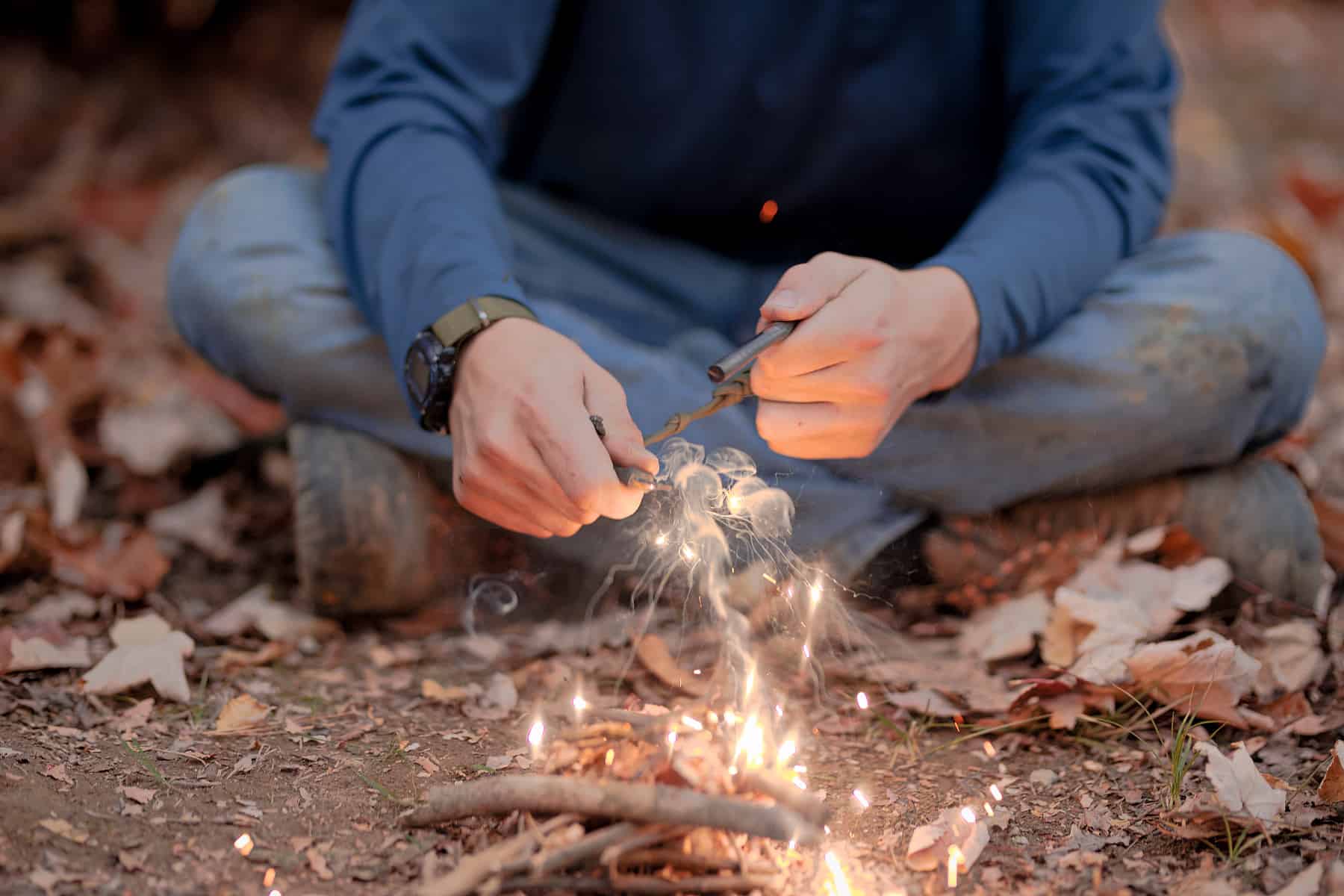
Wilderness Survival Skills for Teens and Tweens
Getting kids outside to experience the wonders of nature isn’t limited to the early childhood years. In a world infused with technology and fast-paced demands, our teens and tweens need the great outdoors more than ever. However, by the time they’ve reached their teen years, our kids are often past the days of playing at the park for hours on end. So, how do we encourage them to continue to love nature, to explore its beauty, and appreciate its allure? Today, Leslie Alvis, Ohio homeschooling mom of four, shares some ideas for engaging your teens (and pre-teens) in the outdoors through the challenge of learning wilderness survival skills.
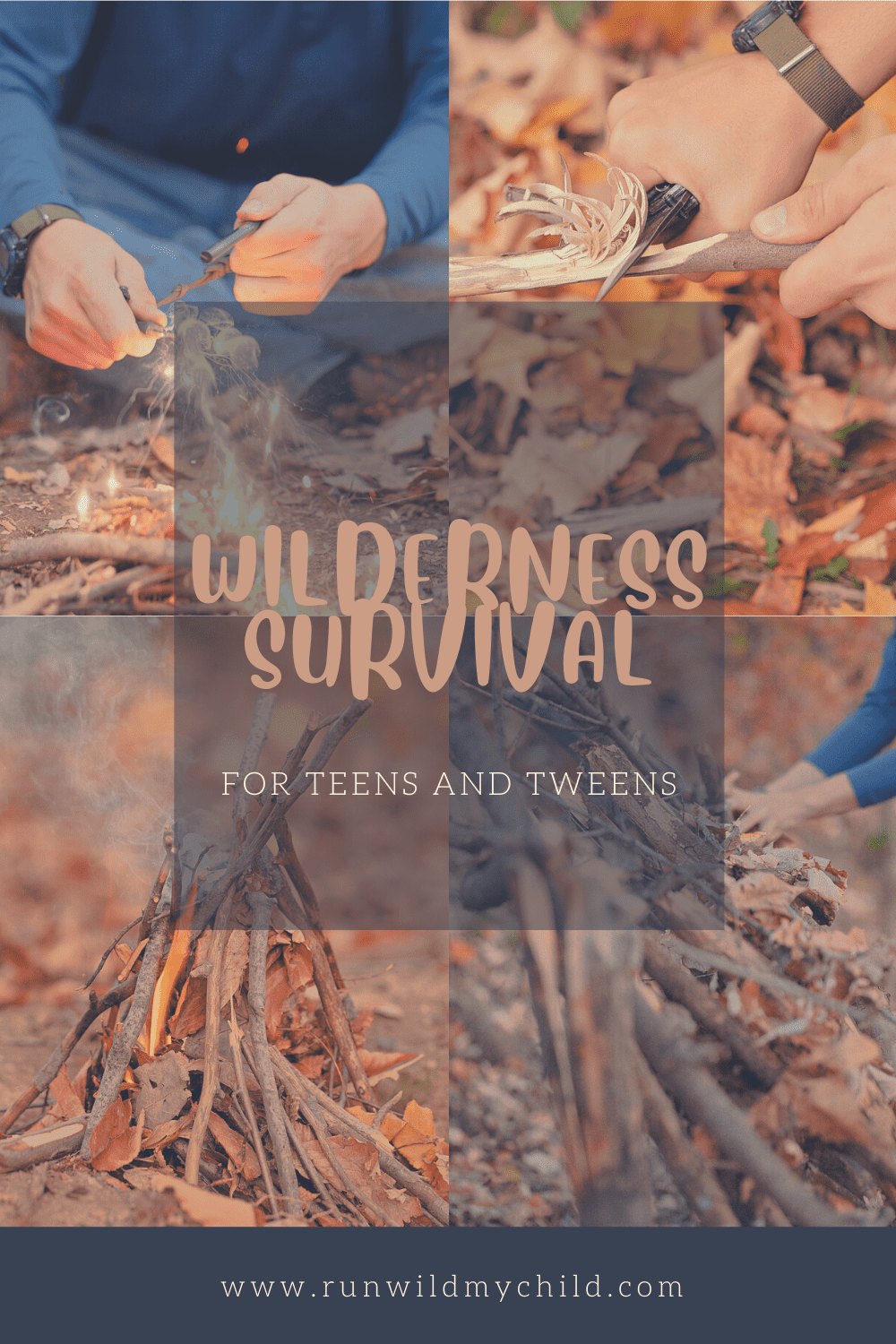
Survival skills are important
Anyone who spends much time out in nature knows that your situation can change in an instant. A storm can blow in, an injury can occur, an insect can sting, or an animal could attack. What started out as a simple hike can quickly become dangerous.
I’m not saying any of this to scare you or deter you from spending time outside. None of us really expect our kids (or ourselves) to be thrust into life-threatening situations in the wild–and maybe they never will be! But, as we raise our kids to love being outside, we should also be giving them the tools to face an emergency that could happen outside.
A level head, an emergency kit, and some basic wilderness survival skills will help them be prepared for the unexpected, both now and throughout their lives. And in the meantime, bushcraft skills are just a lot of fun. Sure, they’re useful in a survival situation. But they’re also a fun challenge for you and your teen to enjoy!
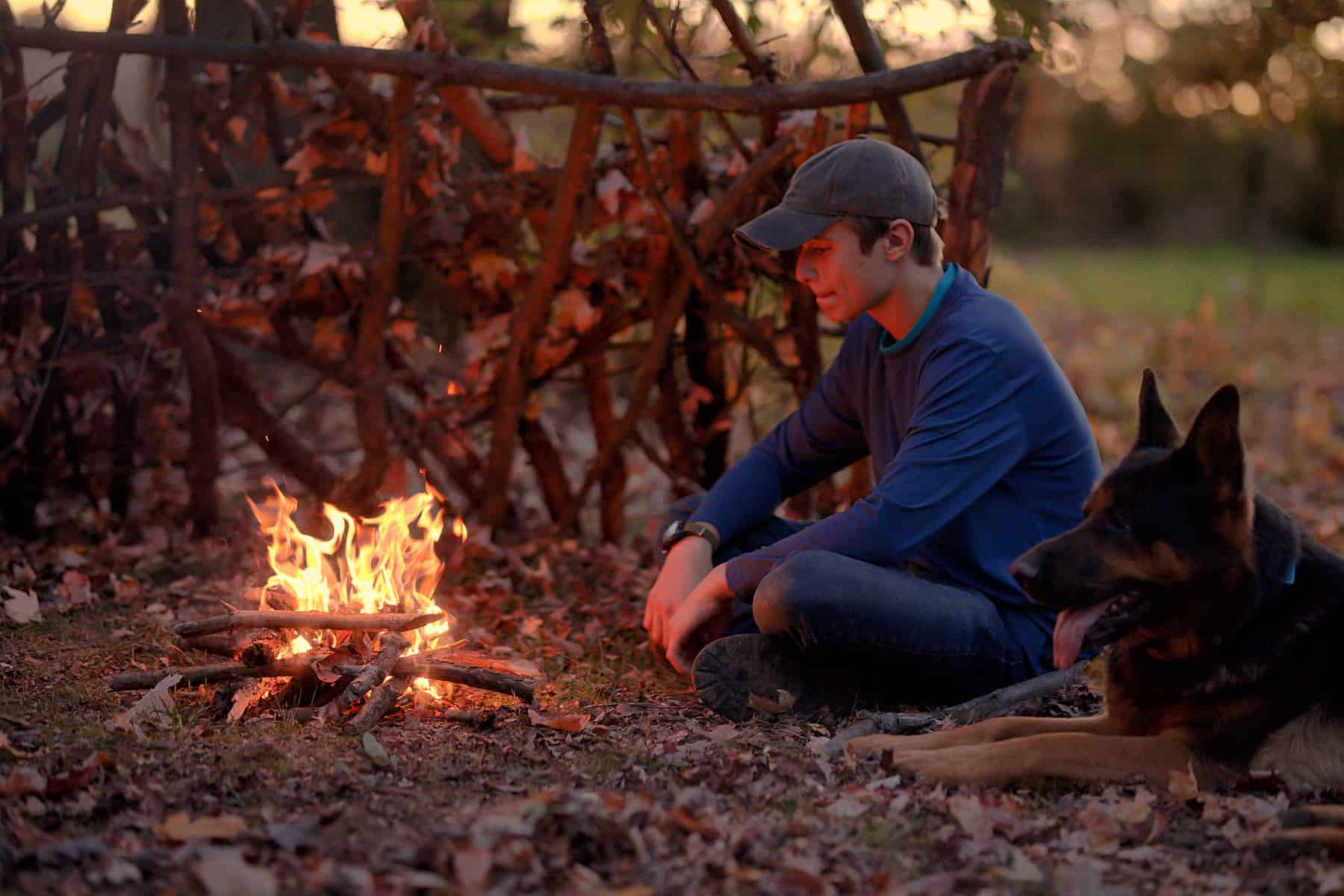
The need for survival skills
Many years ago, wilderness survival skills were necessary for life. It’s hard for us to wrap our 21st-century brains around, but children from past centuries had to acquire survival skills early. They needed to know how to build a fire, to create a shelter, to forage for food—and many of them survived because of those skills.
Today, although wilderness survival skills aren’t necessarily essential for everyday life, they are still good to know for emergency situations. In an emergency, previously acquired skills can mean the difference between life and death. Many of these skills can be useful in everyday situations as well. And wilderness survival skills provide an outdoors-based challenge for the developing minds and skills of our young adults. Plus, many of them are just fun to learn!
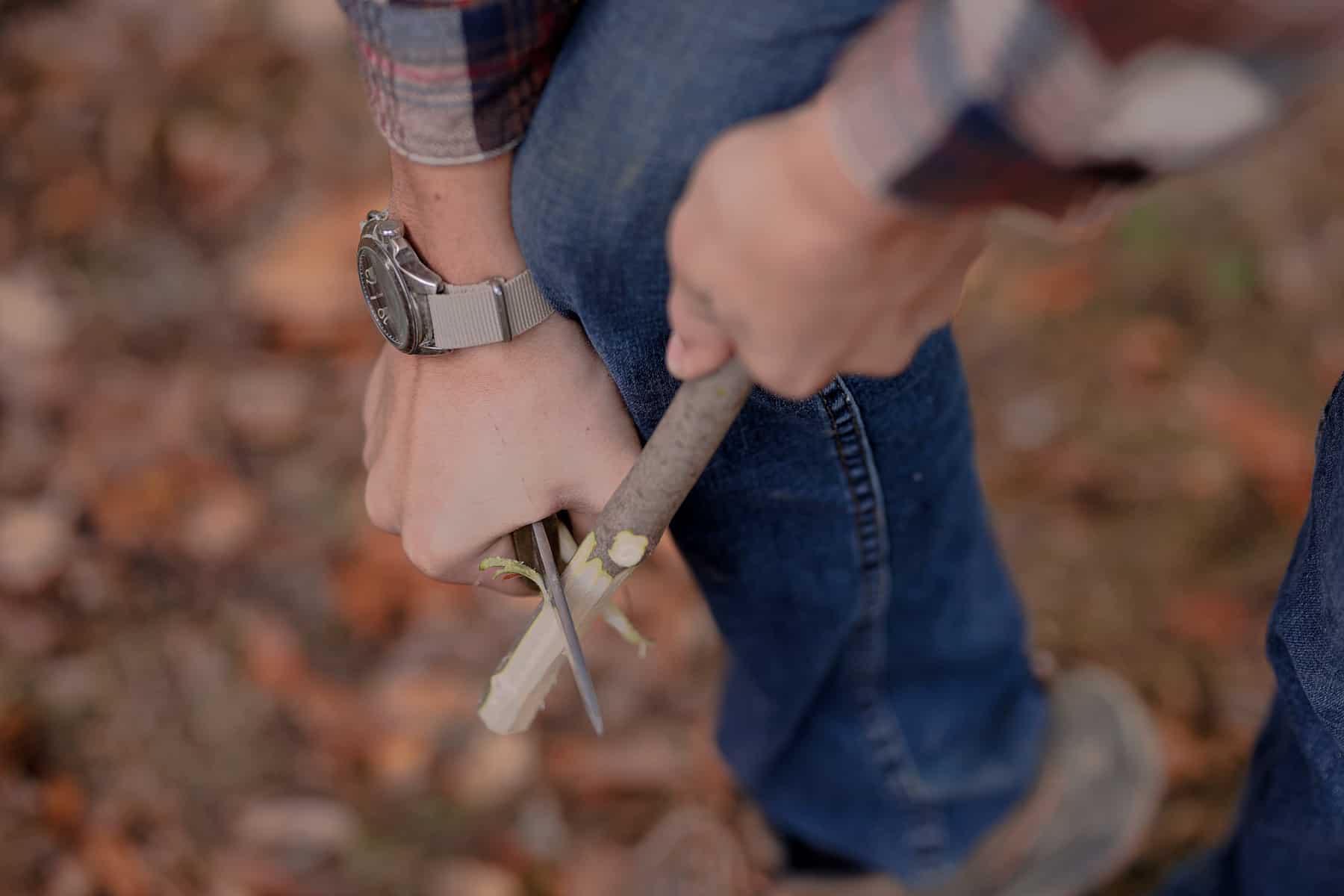
Building outdoors skills
My husband’s younger brother was still in his late teens when our two oldest kids were small. Too old to go outside and just play, this favorite uncle still enjoyed gathering up his little sisters and my kids to “play scouts.” They would pack up some supplies and tromp around in the woods, studying nature, playing survival games, and building forts. They all loved and benefited from the hours they spent doing this.
As kids get older, the way they “play” and spend time outside changes. Our son is thirteen now, and I’ve watched him make this same type of transition from purely imaginative nature play to constructive skill-building outside. Wilderness survival skills have given nature time a purpose and challenge as he’s grown up. It’s given him a reason to spend more time outside (and isn’t that what we all want for our kids, no matter what the age?).
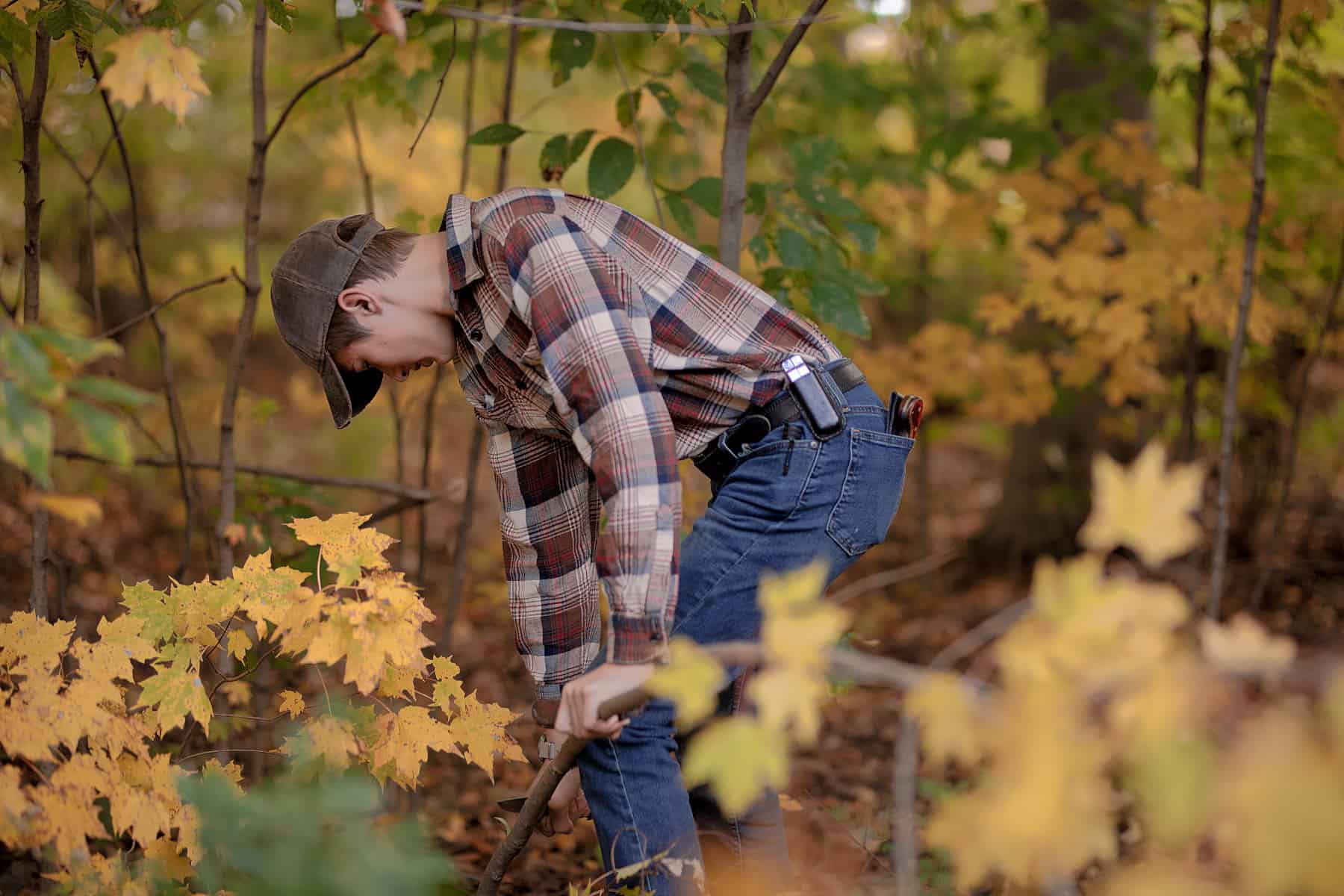
Developing outdoor survival skills is a gradual process
For our kids, the development of these skills has happened gradually. As they aged and matured, they’d get access to an emergency kit and a pocketknife; they learned fort-building skills and fire safety. As our children express interest in these new challenges, we carefully and gradually introduce the tools and concepts for wilderness survival. There’s no magic age for this. In our family, it continues to vary based on interest and maturity. You know your kids best and can judge whether they’re ready or not.
At thirteen, our son is capable and independent with many of these skills. But, he’s not just picking them up right now. His training and experience started very early, working in the woods with his dad and grandpa, and playing with his uncle. He frequently reads woodsman and bushcraft books, and loves to head out to the woods to practice these skills.
As he and I have collaborated on the material for this article, I’ve honestly been amazed at his knowledge of and passion for all things bushcraft. He’s become very proficient in these skills due to practice, persistence, and merely spending time outside getting to know, understand and appreciate nature.
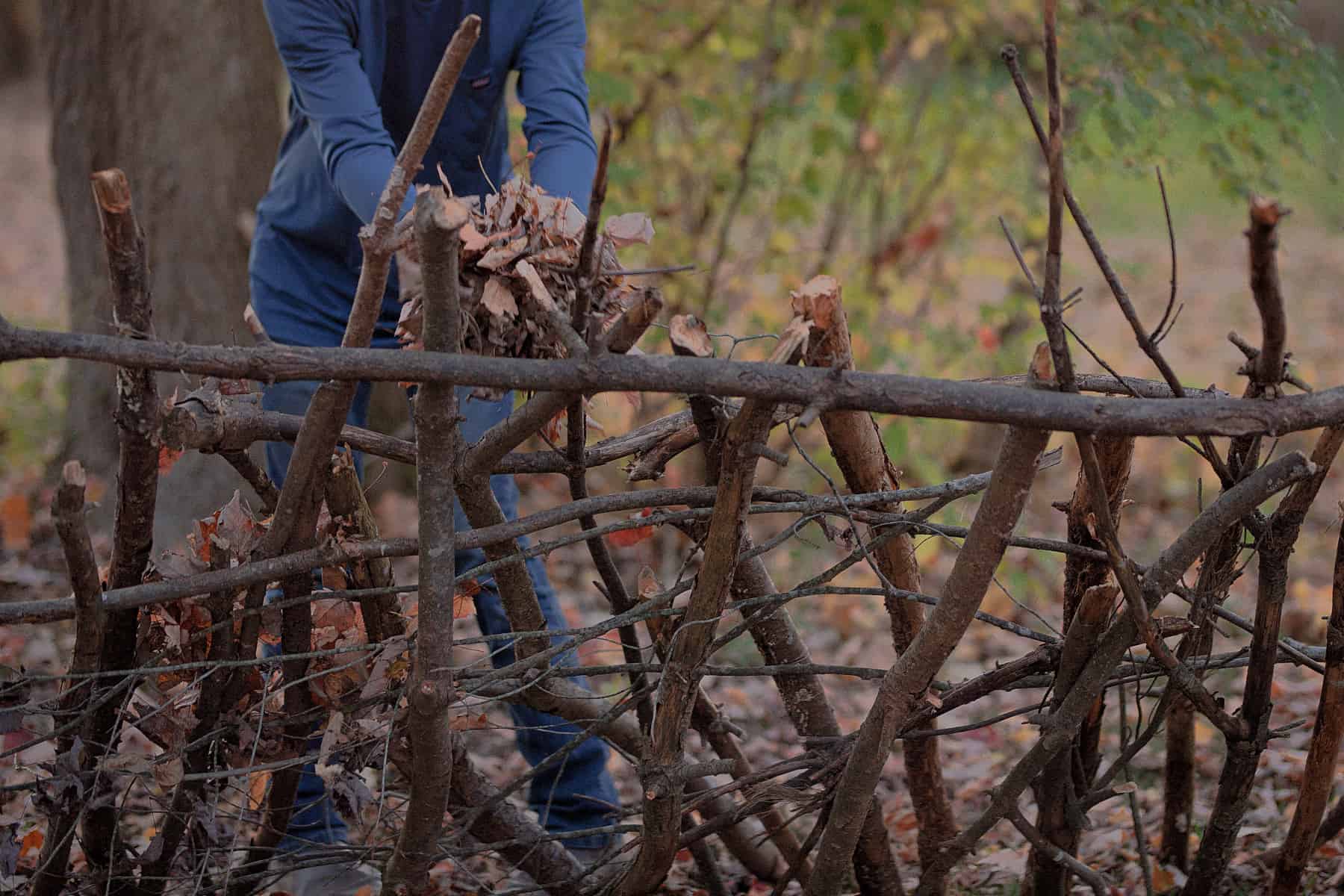
Growing maturity with wilderness survival skills
Each of the wilderness survival skills here will require some level of adult supervision and responsibility, at least initially. Again, as the parent, you know your own children, with their unique abilities and maturity levels. Only you can decide how these skills should look for them. You get to determine what they can handle (and how) based on your own comfort level.
For instance, in the beginning, our children are only allowed to use pocketknives with our permission and supervision. When they have demonstrated capability and maturity with a knife, they may be allowed to carry and use it as they see fit. If we find that they ever use this tool unwisely, we put it away until they grow up a little more. We learn from our mistakes, just as they do.
As parents, our children’s safety is our responsibility. But we also want to see them grow in wisdom and maturity. As they do, it’s amazing to see how a challenge like learning wilderness survival can help them develop and grow.
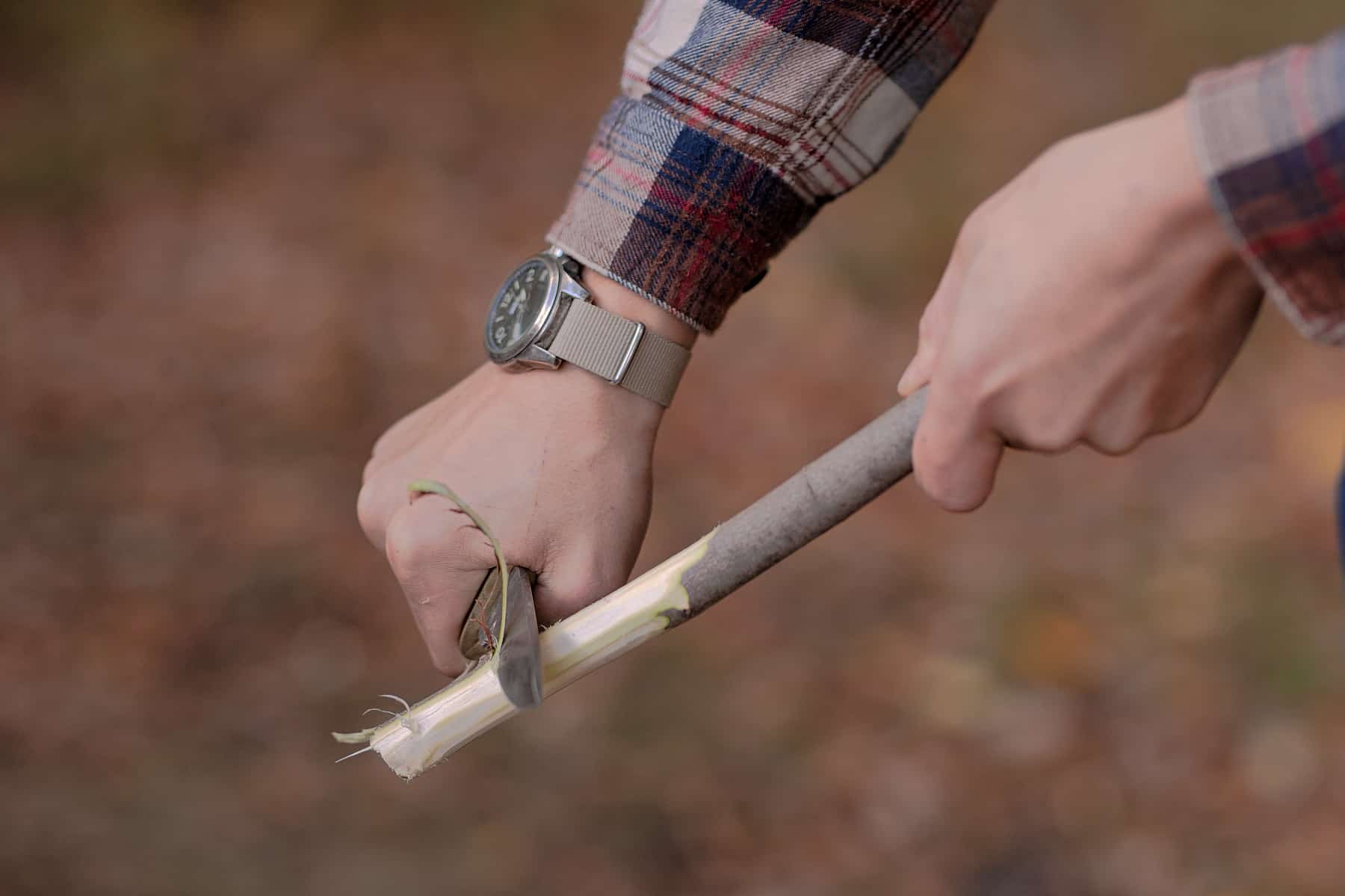
Wilderness survival skills for teens and tweens
If you’re interested in encouraging your teens (or pre-teen) to spend more time outside and learn some valuable lifelong skills in the process, we’re here to help. Here are some wilderness survival skills that perfect for teens and tweens.
Make a survival kit
Making a survival pack is a fun and simple way to begin developing wilderness survival skills. Even a younger child can create a survival kit for a family hike or for a solo adventure like building a fort in your own backyard. It’s a great way to help kids begin to be prepared for the unexpected in nature. A survival pack doesn’t have to be fancy—just a backpack or little pouch with some basic tools and provisions.
Items you can include in a survival kit:
- First aid kit (our kids have created their own)
- Non-perishable snacks
- Water
- Flashlight
- Emergency blanket or rain poncho
- Rope
- Compass
- Knife or multi-tool (depending on age and maturity)
- Fire-starting tool (also depending on age and maturity)
I’ve been amazed at what my older kids pull out of their packs sometimes. They’re better than I am about carrying first aid supplies on outings and hikes. I can’t count the times our son has used his survival kit to supply or create something useful when we’re outdoors. When we’re working at our homestead property, I often find him unloading a small cast iron skillet and canned goods from his pack, building a fire, and heating a snack for himself and his sisters. Our girls haven’t reached that stage of independence yet, but I love how thinking ahead helps them be helpful and prepared for different circumstances on our nature adventures.
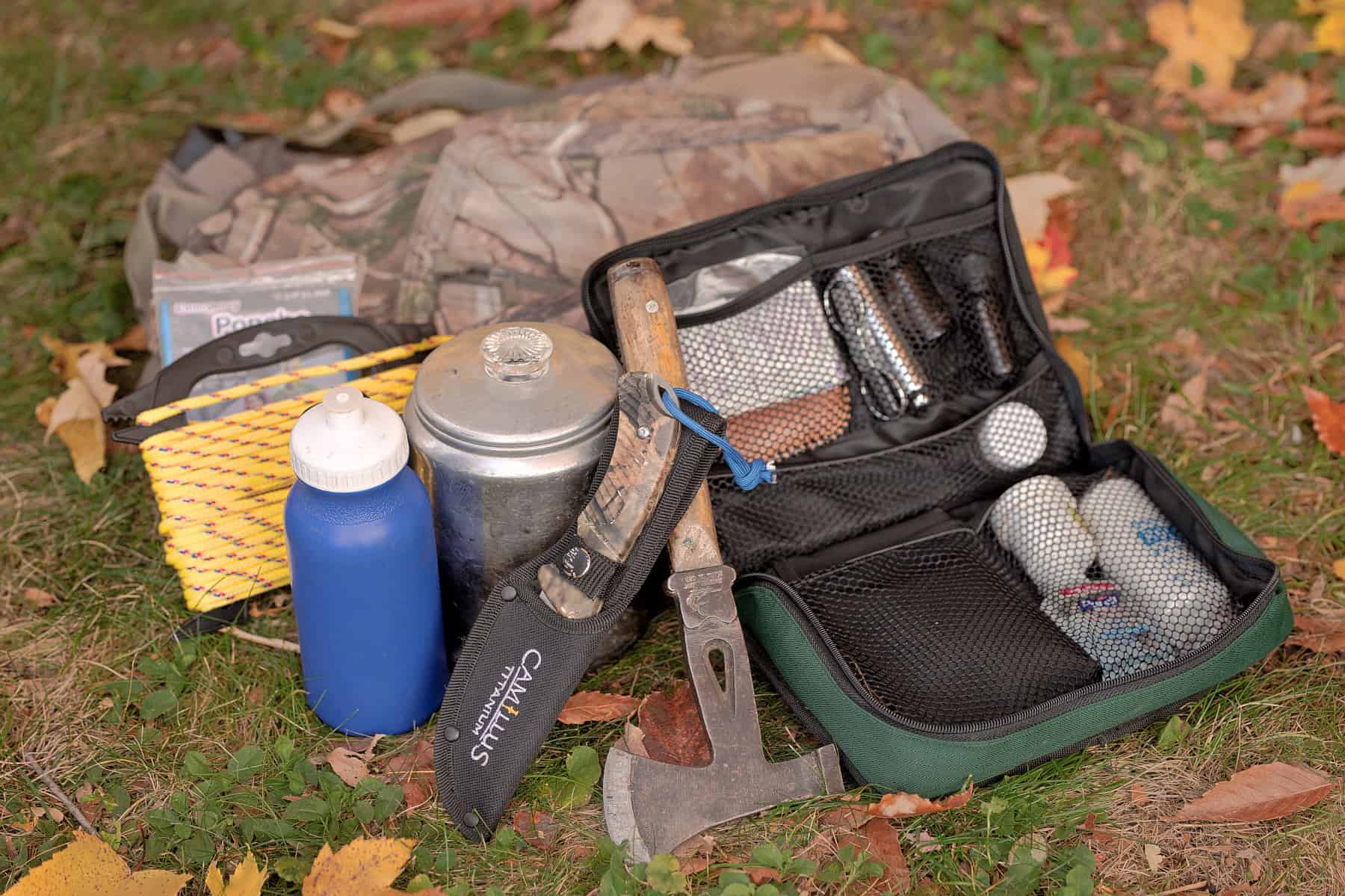
Teaching survival skills to teens (and learning yourself)
Before we cover some key elements of wilderness survival, I’d like to mention that some bushcraft skills may sound intimidating. In particular, handling sharp tools and starting fires might be scary, especially if they are out of your own comfort zone! They sound even scarier when you consider your child doing them. I am in no way advocating turning your child loose with anything. All of these skills require a learning period, patient instruction, and some maturity. With time and practice, he or she can gain safety and competence.
If you’re not comfortable or knowledgeable about these skills, don’t let that stop you. You and your teen can learn together. Letting them see you learn something new is encouraging and shows them that learning a new skill can happen at any age. If you don’t know where (or how) to get started, don’t be afraid to ask for assistance! For instance, if your teen or tween is interested in learning more about safe knife handling, but you’re not comfortable teaching it, consider reaching out to a trusted adult for help. Somewhere in your circle of family and friends, you probably know someone who is a fisherman, a hunter, or a dedicated hiker.
People with hobbies like these often have a keen interest in wilderness survival skills. Many of them also love to share this knowledge, especially with the next generation. So, if you feel insufficient to teach/supervise any of these skills, look around for someone you trust to help you. And try learning right alongside your teen! You will never regret the time you spend together, discovering new skills and spending time in nature.
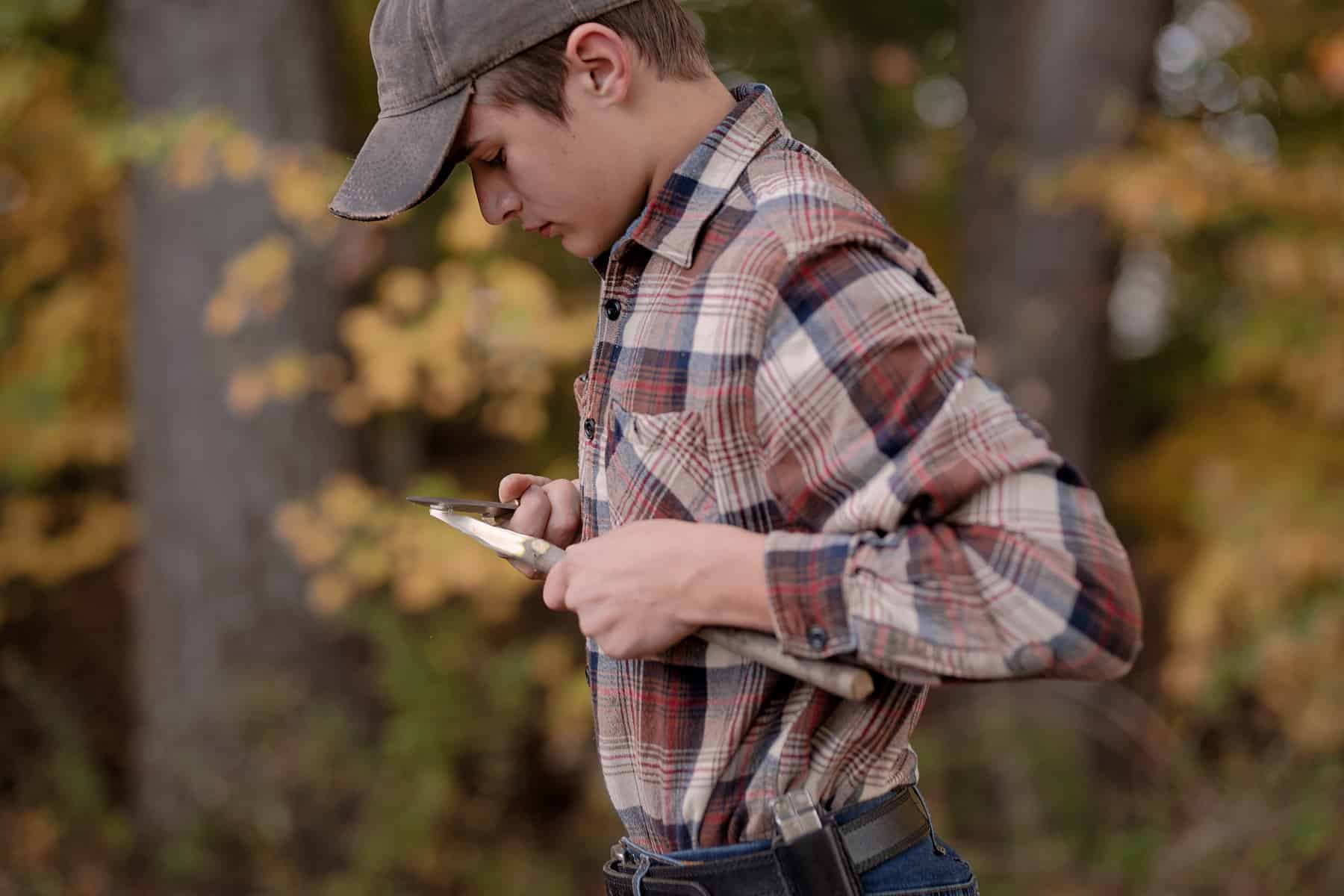

The Five C’s of wilderness survival
In Bushcraft 101: A Field Guide to the Art of Wilderness Survival, author Dave Canterbury identifies the key elements of survival skills as the Five C’s. Here are the Five C’s of wilderness survival:
- cutting tools
- combustion
- cover
- containers
- cordage
Other guides label them in different ways, but we think the Five C’s make a helpful and memorable presentation of these skills. So, with due credit to the author for his outline, we would like to share with you the first three key elements of wilderness survival.
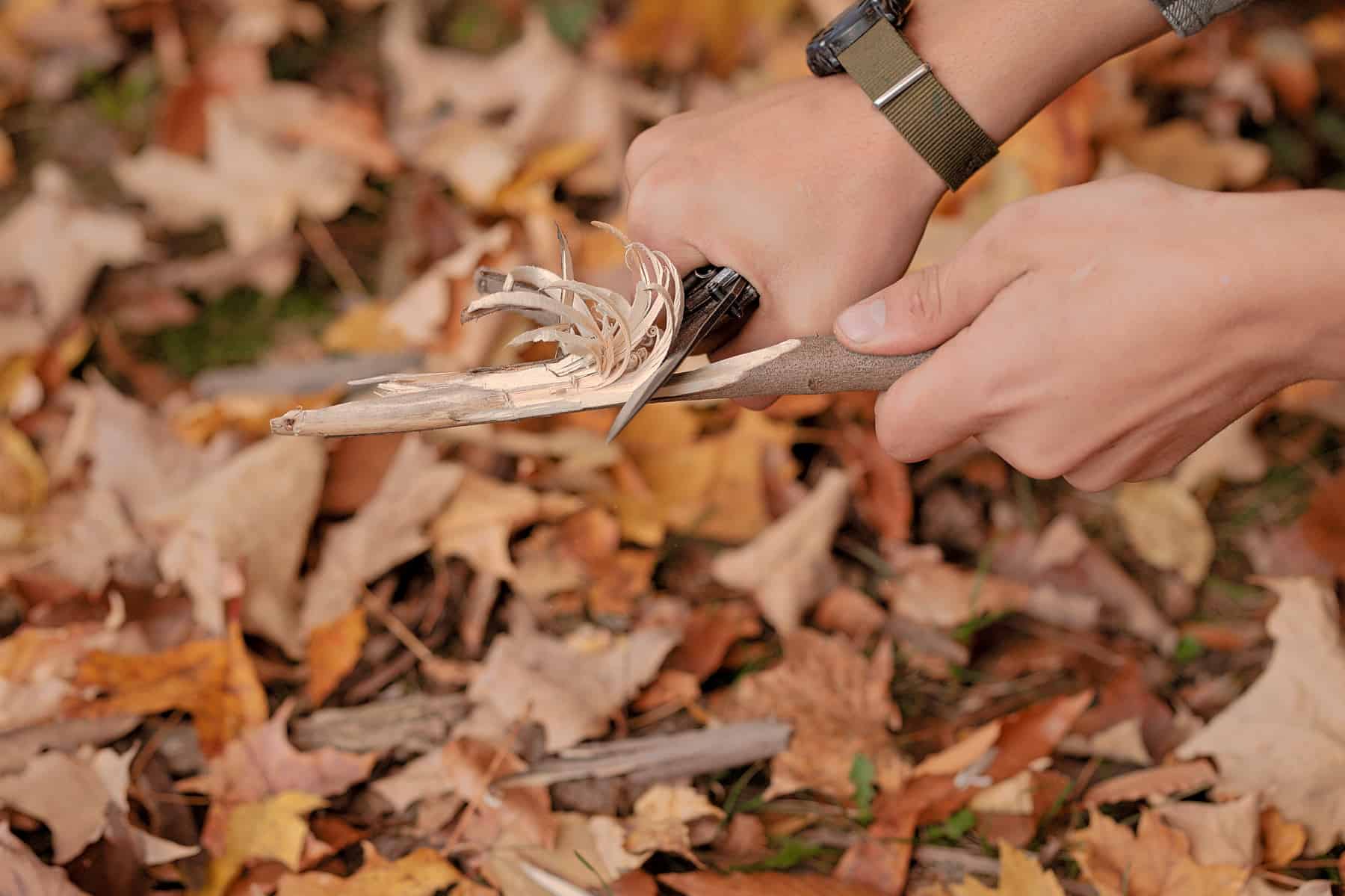
1. Cutting tools
The first C of wilderness survival is a cutting tool. Once again, this is something that may initially require your supervision and participation with your child. But, a sturdy pocketknife, multi-tool, or hatchet is one of the top tools necessary in a wilderness survival situation.
A knife should be attached to you, worn on a belt, or in a secure pocket. This is the one thing you never want to be without in an emergency. With a knife or other cutting tool, you can create a fire starter, cut materials for fire and for shelter, and recreate almost any other tool you will need to survive. A knife can also be vital in emergency medical situations (cutting bandaging, removing clothing) and rescues (cutting away obstructions or creating other tools to work with).
In the meantime, gaining skill and competence with a pocketknife or hatchet is a fun challenge for any teen.
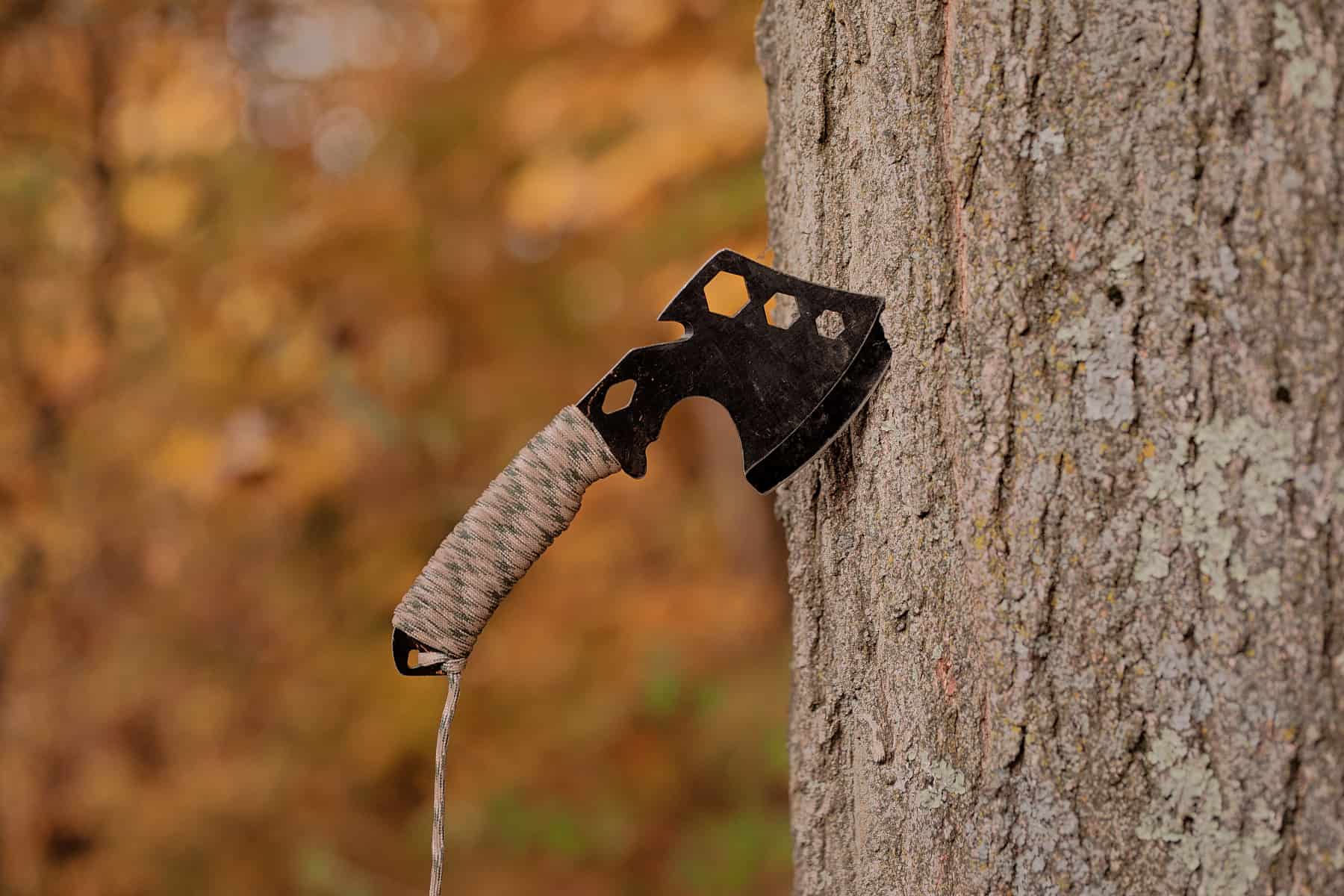
Cutting tool options
Because a knife is essential for so many areas of wilderness survival, it’s important to own a good one. The Field and Stream Total Knife Manual is a complete guide to any and every kind of knife, its pros and cons, with every style and brand known to this modern world. On our shortlist of most useful knives, though, are these suggestions:
- Pocketknife: Sturdy, simple, and compact, this knife has a strong blade that locks open, preventing it from accidentally closing on your hand. As a basic survival tool, this knife is adequate and effective for a number of tasks.
- Multi-tool: A step up from a basic pocketknife, the multi-tool provides a number of useful features in one tool. Although this brand is pricey, the quality and durability of their tools is proven. In our experience, they last forever and work for everything.
Learning knife safety early
We live in a rural area where many of our friends and family members carry a pocketknife or multi-tool at all times. A cutting tool is useful for so many tasks in our lifestyle. With that kind of mindset, our kids have asked for pocket knives pretty young.
When we think they can handle a knife without being a danger to themselves, we let them start using one for some basic whittling or cutting. They’ve had to learn basic safety rules:
- do not ever cut toward your body,
- do not move around with an open blade, and
- no using a knife with other kids close to you.
Only after we see them demonstrating responsibility and maturity with those guidelines do we consider letting them carry the knife or using it on their own.
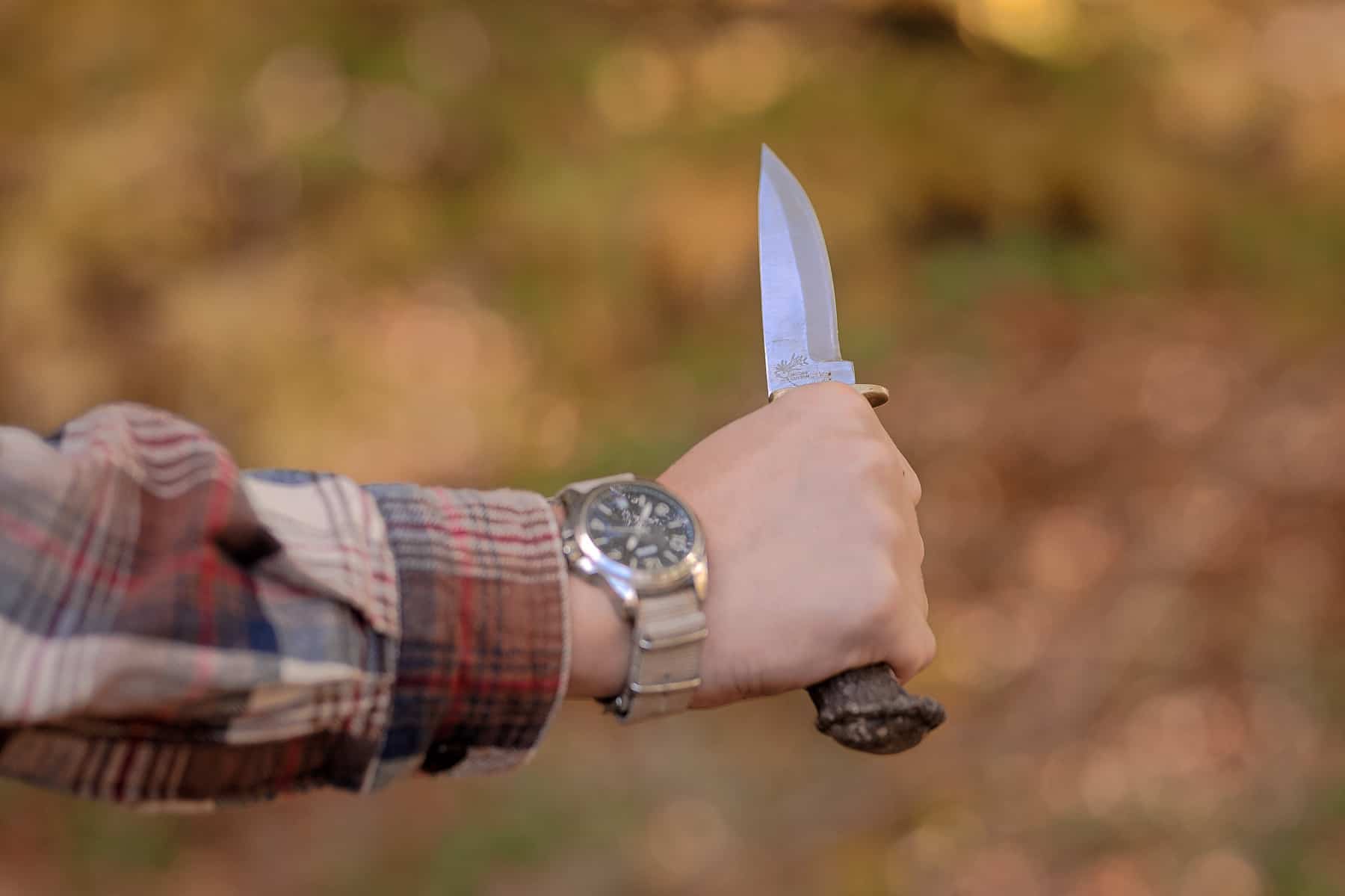
2. Combustion: tools and skills to make a fire
Another key element of wilderness survival is fire. Although it might sound a little scary, the skills and tools to create fire are essential in emergency situations. They also come in handy in many everyday situations throughout life. With proper instruction and supervision, your teen or preteen can learn these skills safely and gain efficiency in fire starting.
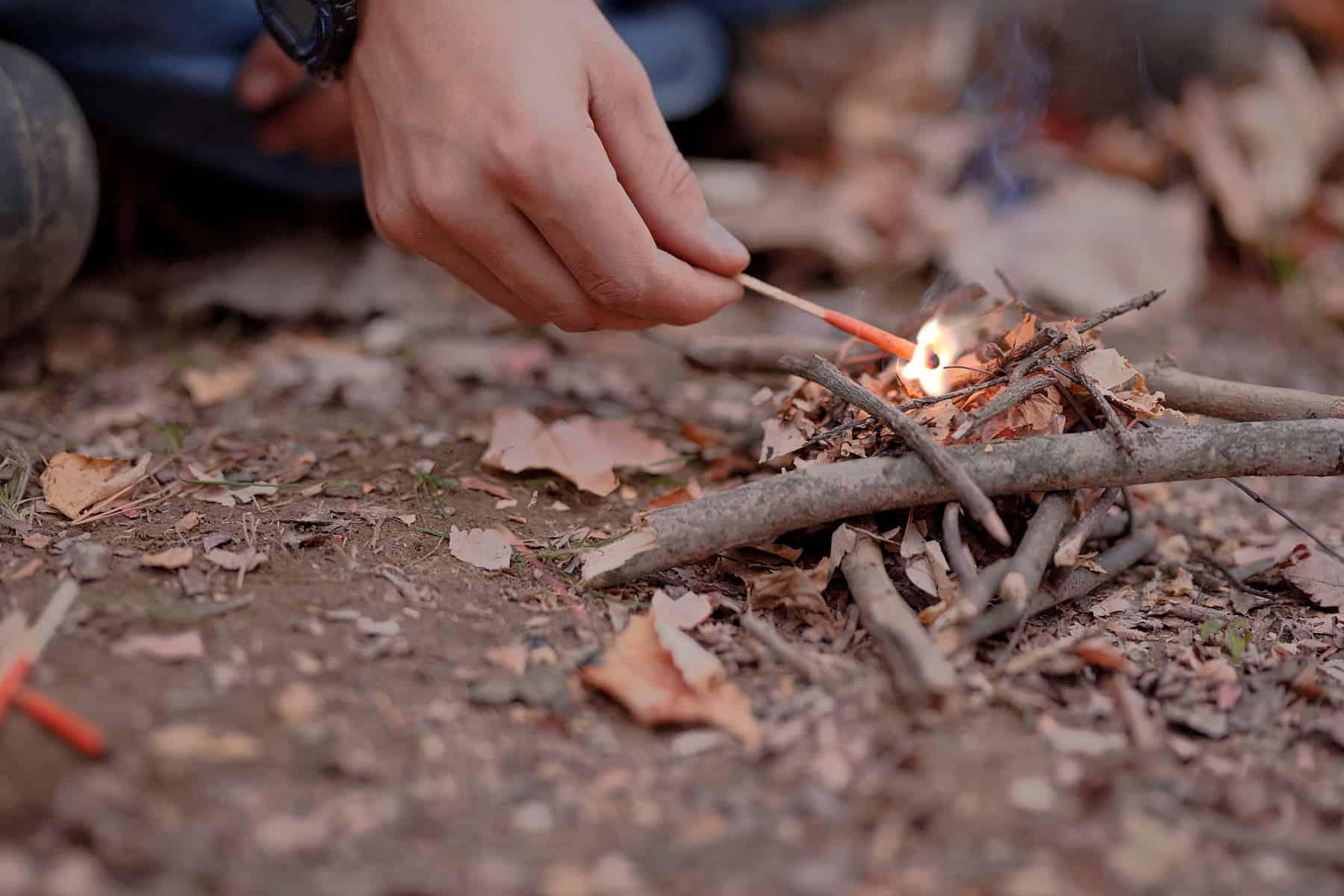
Start with fire safety
Since we heat our home with wood, as well as burn a lot of outdoor fires, our kids have been exposed to fires and learned safety rules from toddlerhood. Early on, we teach them never to get near a fire, and never to mess with matches or lighters. But, as our son approached his preteen years, he was demonstrating carefulness, capability, and a lot of interest in fire starting. We’ve continued to emphasize fire safety, but allowed him greater responsibility in building and maintaining fires.
For him, the rules of fire safety are now more focused on choosing a smart location when building a fire, helping his little sisters be careful around the fire, and making sure it is properly contained. It’s also important to know and follow local burning regulations wherever you are. Wilderness survival skills always include being aware, smart, and ethical about your choices.
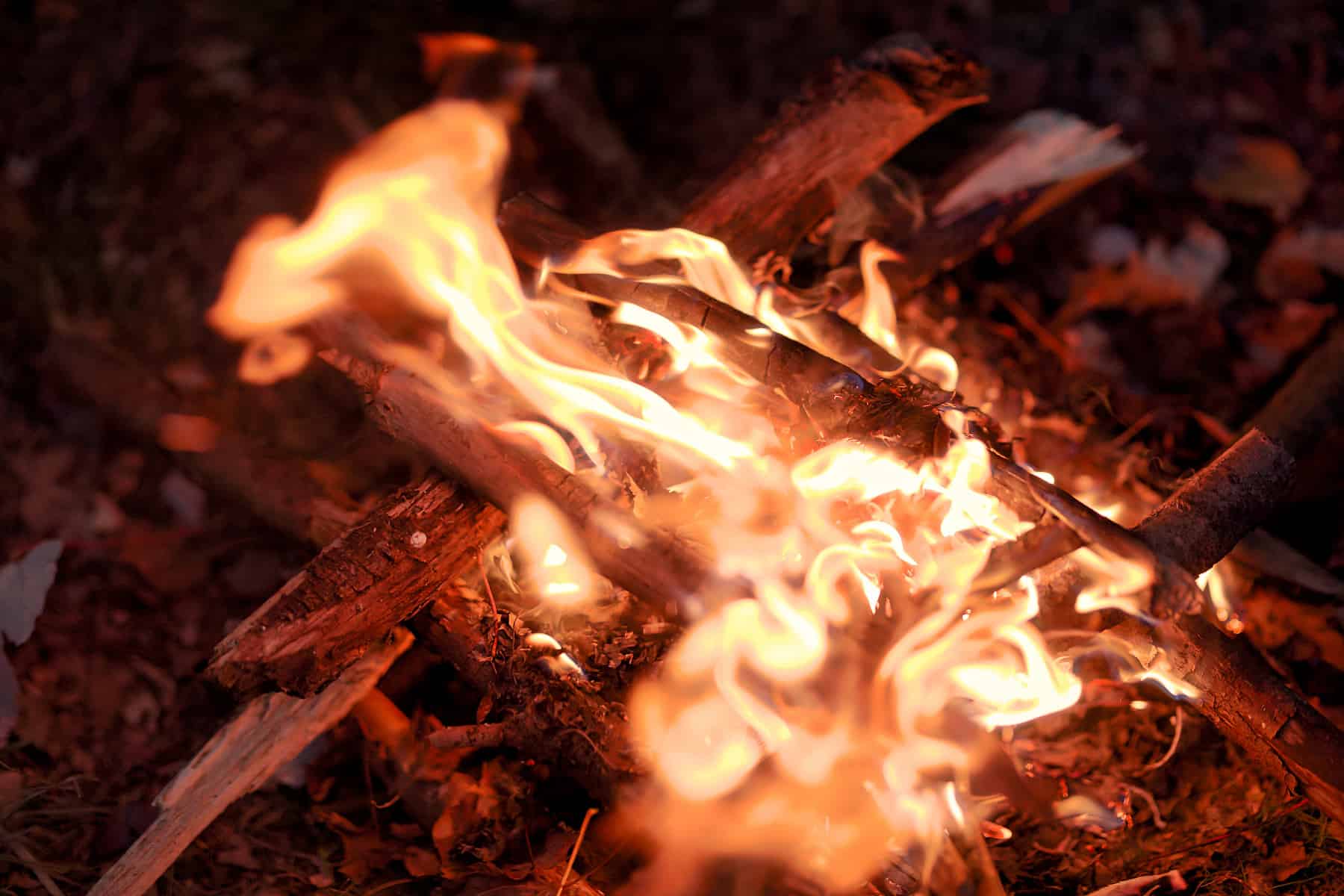
Fire starting skills
Building a fire in a sheltered area with dry kindling is a great way to start. But wilderness survival takes fire building much farther. If you’re ever in an emergency situation and need a fire, you might not have ideal conditions for starting it. Bushcraft skills teach you how to use the materials you have on hand to create fire for heat, protection, and cooking. It takes practice to learn to build fires with wet materials or without a lighter, but it can be done. And it’s a fun outdoor challenge for a teen to learn!
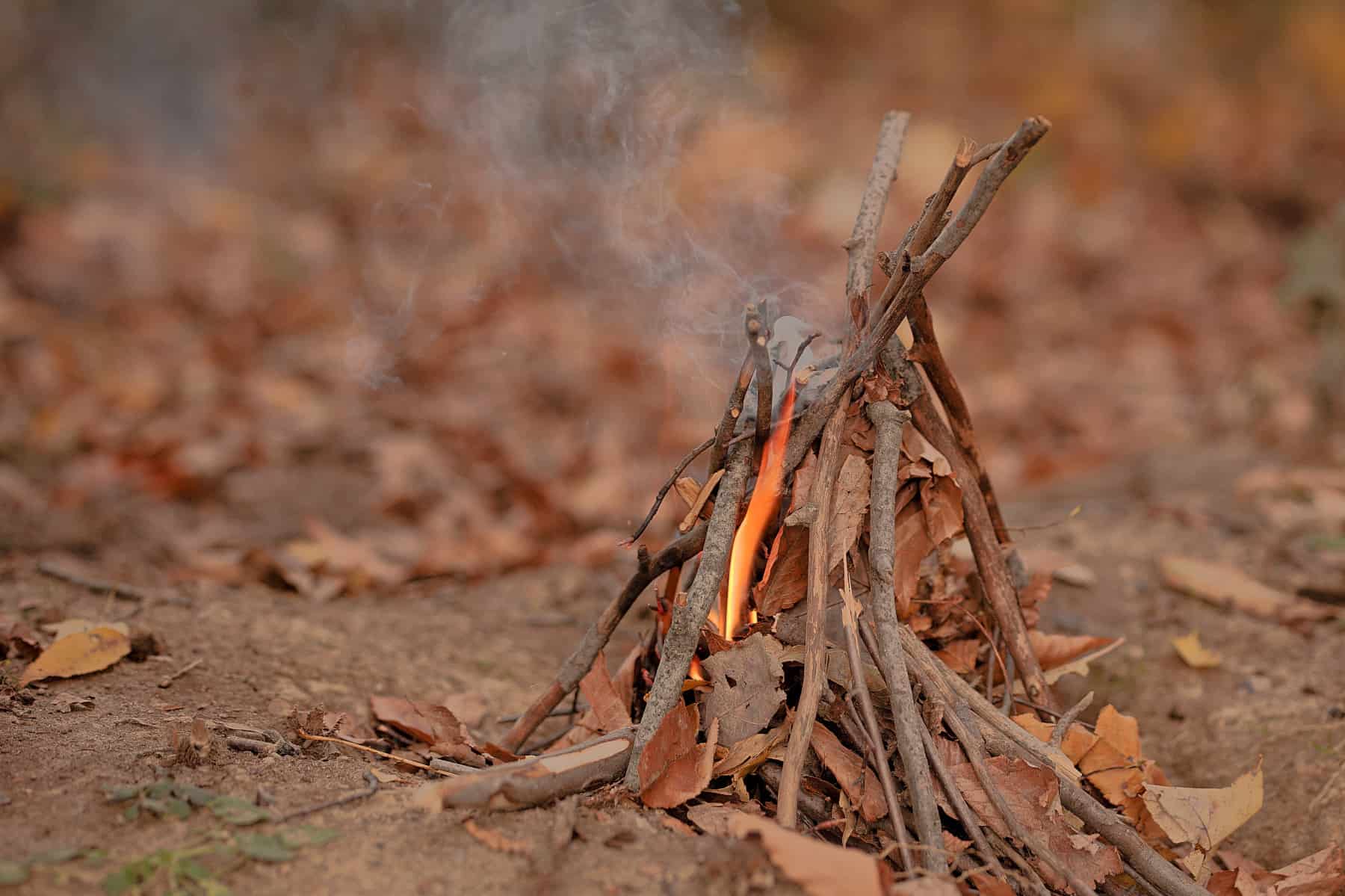
Choose a proper fire location
To build a safe and efficient fire, find a location that is sheltered from the wind. Scrape away all debris, down to the dirt, in a wide ring around the fire area. If possible, build a stone ring around your fire to help contain it. (Use dry stones, since wet rocks can explode if they’re heated too rapidly!) If there aren’t any stones available, try digging a depression into the dirt or building a small dirt wall around the fire. Practicing wilderness survival skills always includes showing carefulness for the environment surrounding you. This includes keeping the fire contained and controlled.
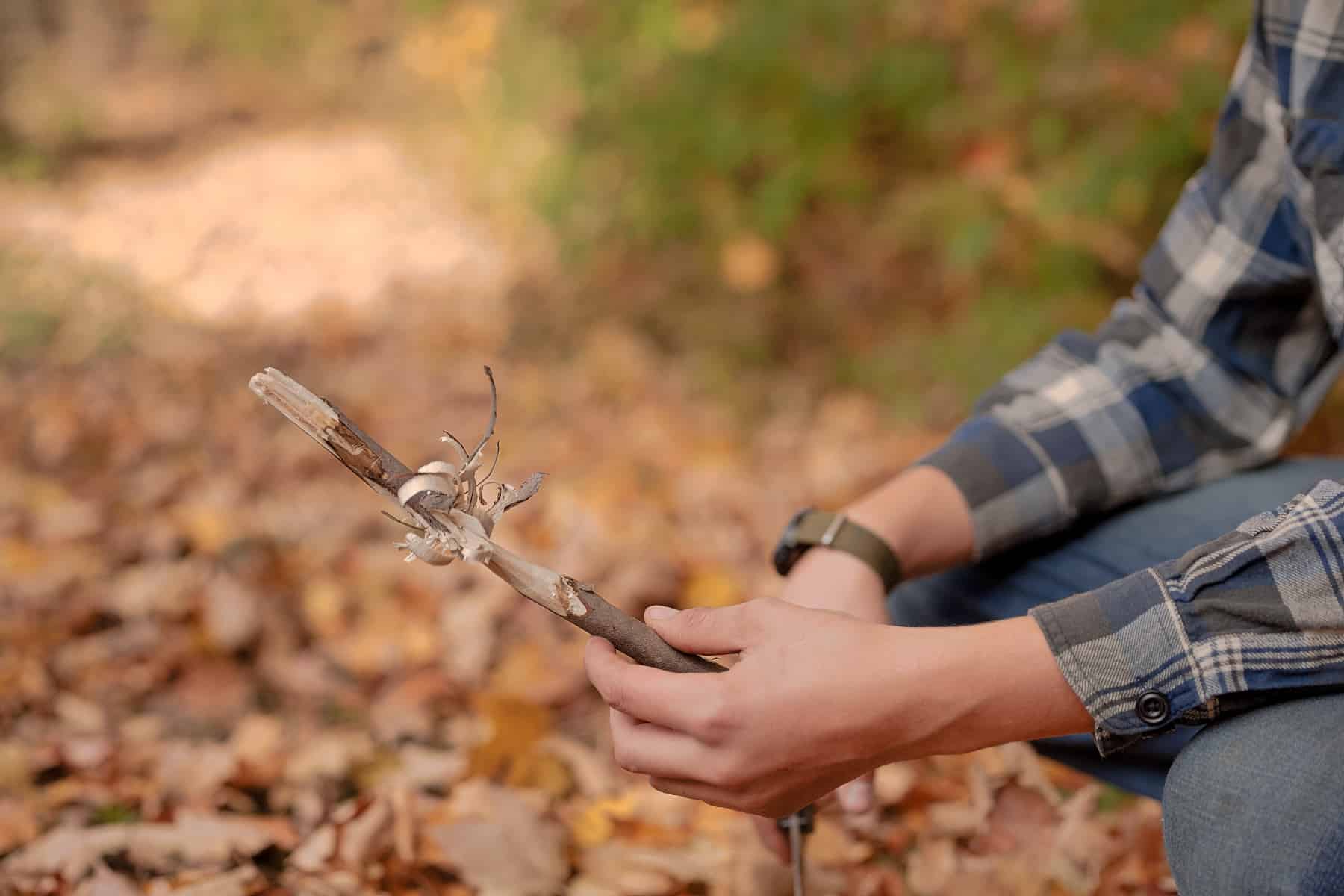
Fire starting materials
Look for small twigs, leaves, or dry grass for fire-starting material. If it has been raining or snowing, try to find an evergreen tree. In wild areas, the lower, dead limbs of evergreen trees haven’t been trimmed away. Sheltered by the overhanging branches, they provide the perfect source for dry fire materials in a wilderness survival situation. If you’re having a hard time finding dry starter material, you can use a knife to shave one end of a dry stick to carve a “feather stick” (pictured above) to help light your fire.

Starting the fire and choosing a firestarter
Ideally, your wilderness survival kit will contain some way to create a spark. A small lighter, waterproof matches, a magnifying glass, or a ferrocerium rod can all serve as fire starters. While some are easier to use and/or more reliable than others, part of the fun of developing survival skills is learning to start a fire with what you have on hand. I think the dramatic sparks from the ferrocerium rod (shown above) might be the most exciting way to try to start a fire!
Once you have a flame going, gradually add small bits of dry leaves and twigs. Feed the fire slowly with lightweight materials until the flame is steady and strong. Be careful not to smother the fire or let the wind blow it out! With some patience and wilderness survival skills, you can have a strong fire to provide warmth, light, and protection in almost any situation.
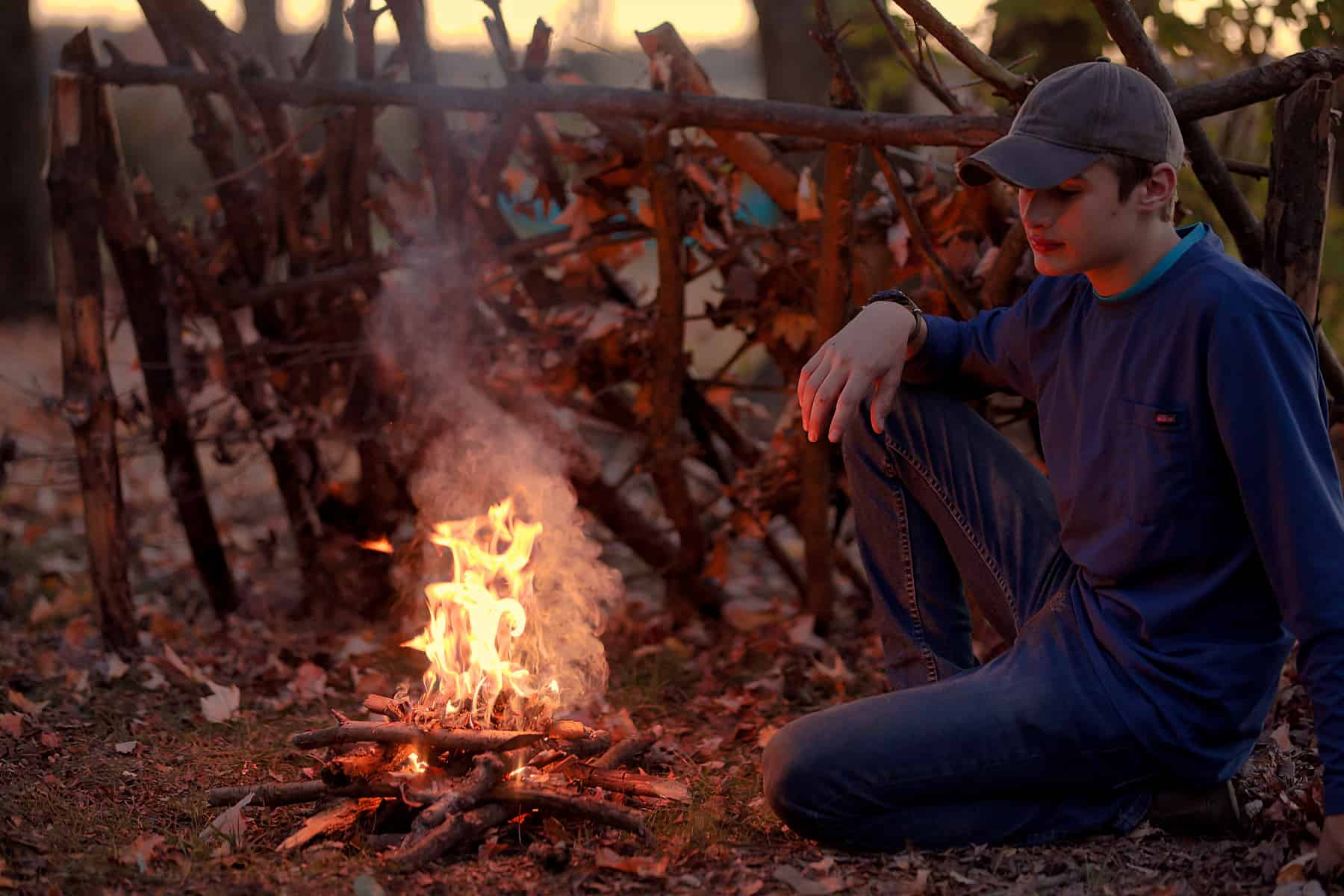
3. Cover: shelter in the wilderness
The third C of wilderness survival is cover. If you’re ever stranded in the woods, injured on a hike, or caught in a storm, you need to be able to take shelter. Survival may depend on you knowing the most efficient way to use the materials around you. This is a great challenge for teens and tweens! Survival skills add a whole new dimension to fort building.
First, look around for any natural cover. A cave, a crevice in a hillside, or a ravine can help provide shelter. But sometimes there isn’t a natural cover to be found. If you need to build a simple survival shelter, you can gather materials from around you and build this basic shelter. You need two stakes to drive into the ground, a ridge pole to run between them, and smaller branches to lean against them. The stakes determine the height of the shelter, and the ridgepole its width.
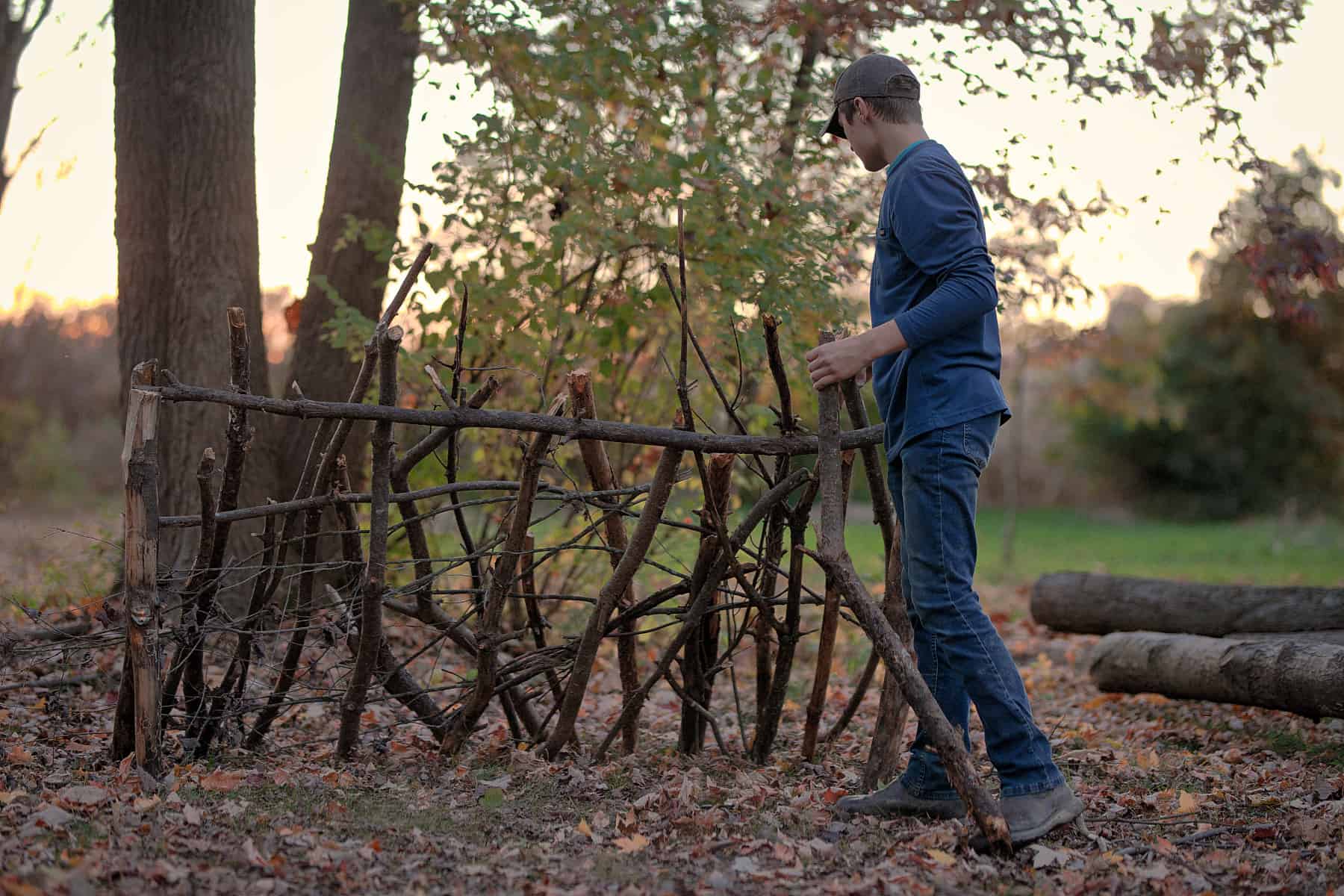
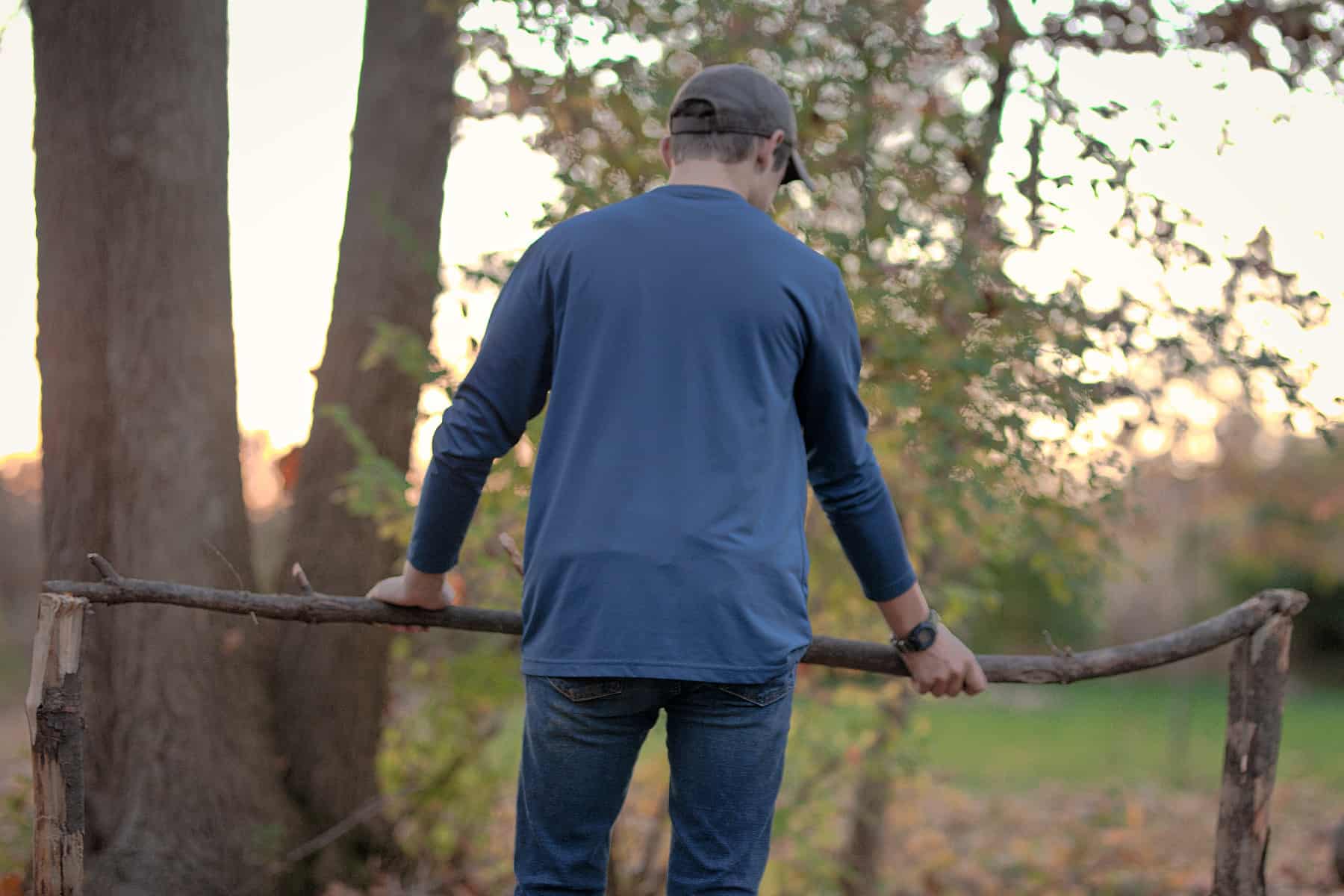
Shelter building basics and tools
A hatchet really comes in handy for creating the point on the stakes, plus a notch in the top for the ridge pole. You can use the flat edge of the hatch to drive the stakes in or use a rock. Once you have your stakes set and the ridge pole set, lean the smaller branches against the ridge pole as thickly as possible. If there are evergreen trees nearby, evergreen branches make an ideal cover against wind and rain. But part of wilderness survival is learning to use what you can find. In the spring and summer, green leafy branches will also work. In the fall and winter, gather armfuls of fallen leaves to fill in the gaps in the wall.
The thicker you pile the branches and leaves, the better shelter you will have. Even dried leaves provide surprisingly good protection from the elements. Being able to build a shelter is one more skill your teen will enjoy learning as he or she gains proficiency in wilderness survival skills!
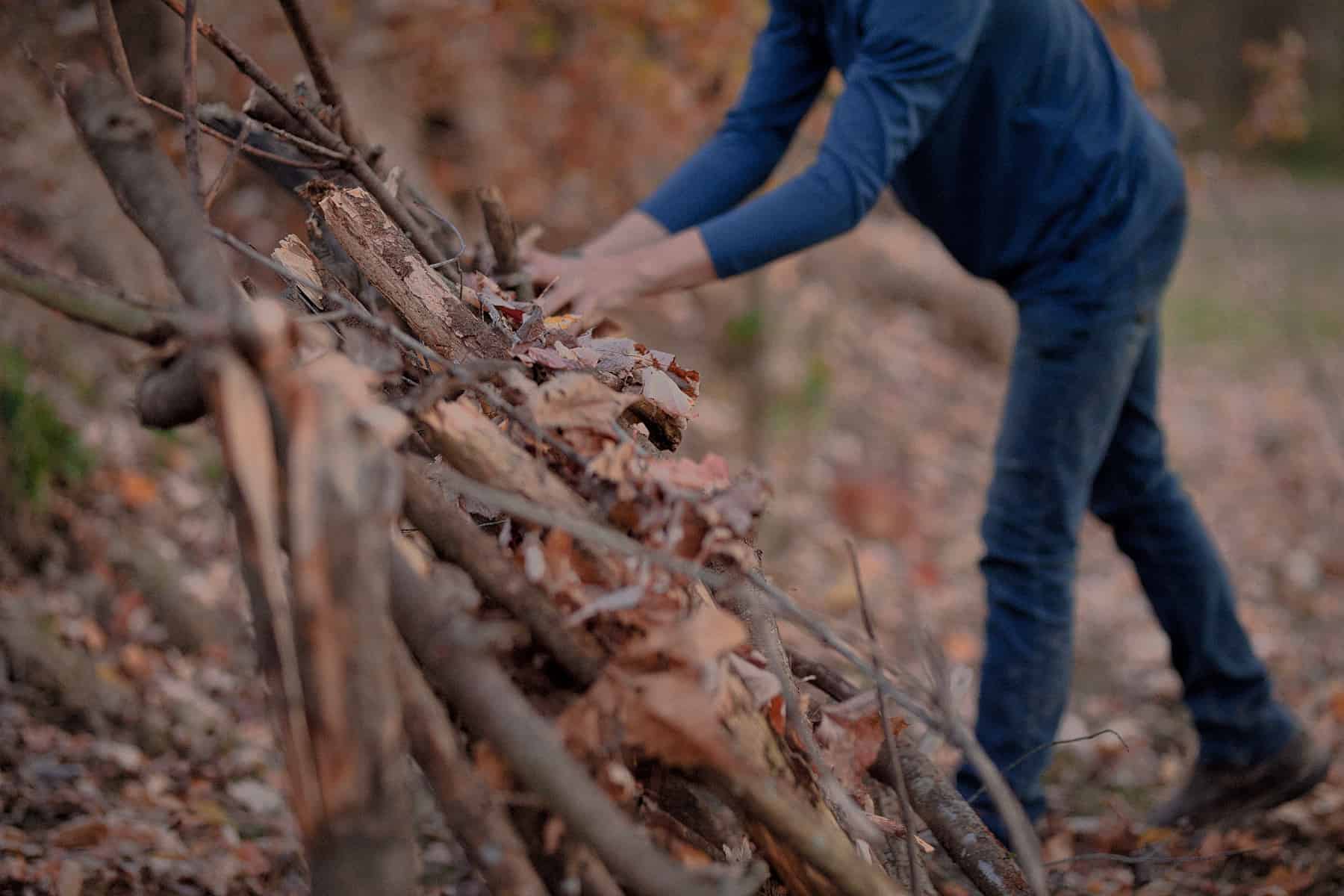
Practicing wilderness survival skills
Although all these wilderness survival skills are helpful in an emergency situation, they’re also just a lot of fun to practice throughout life. The basics aren’t hard to learn, and there are many ways to continue to develop better bushcraft skills. From how to light a fire without man-made materials to creating a drinking container out of natural materials, survival skills can present endless new challenges and encourage your kids to spend more time outside.
So head outside with your teen, and see what skills you can learn together!
Is your teen interested in wilderness survival?

About the author
Leslie is an Ohio farm girl and chaser of light, children, and sometimes chickens. She’s a lover of Jesus, wife to her high school sweetheart, and a homeschooling mom of four wild rascals who love the great outdoors as much as she does. As a family, they love hiking, camping, fishing, and just about any outdoor activity. She and her husband are just beginning the process of building a homestead from the ground up, doing most of the work themselves. Leslie has a lifelong obsession with writing and capturing everyday life from behind the lens. Follow along with their homesteading, homeschooling, and everyday adventures on her Instagram account.
You can find more from Leslie in the following locations:
Instagram: @c_l_allofus
Client work: @lalvisphotography
Leslie’s RWMC posts:
Comments
7 responses to “Wilderness Survival Skills for Teens and Tweens”
[…] teaching children wilderness survival skills, it not only instills confidence, boosts self-esteem, and provides exercise, but it also […]
[…] Wilderness Survival Skills for Teens and Tweens • RUN WILD MY …Dec 3, 2021 … cutting tools; combustion; cover; containers; cordage. Other guides label them in different ways, but we think the Five C’s make a helpful and … […]
[…] Wilderness Survival Skills for Teens and Tweens • RUN WILD MY …Dec 3, 2021 … So, how do we encourage them to continue to love nature, to explore its beauty, and appreciate its allure? Today, Leslie Alvis, Ohio … […]
[…] ones are toxic. This skill can be taught while hiking or exploring the wilderness. According to RunWildMyChild, it is important to teach children how to identify and avoid dangerous plants such as poison ivy, […]
[…] Source: runwildmychild.com […]
[…] to the survival kit, young explorers should always have a reliable cutting tool. A sturdy pocketknife, multi-tool, or hatchet can be invaluable in numerous wilderness situations, from cutting branches to creating shelter […]
[…] Source: runwildmychild.com […]

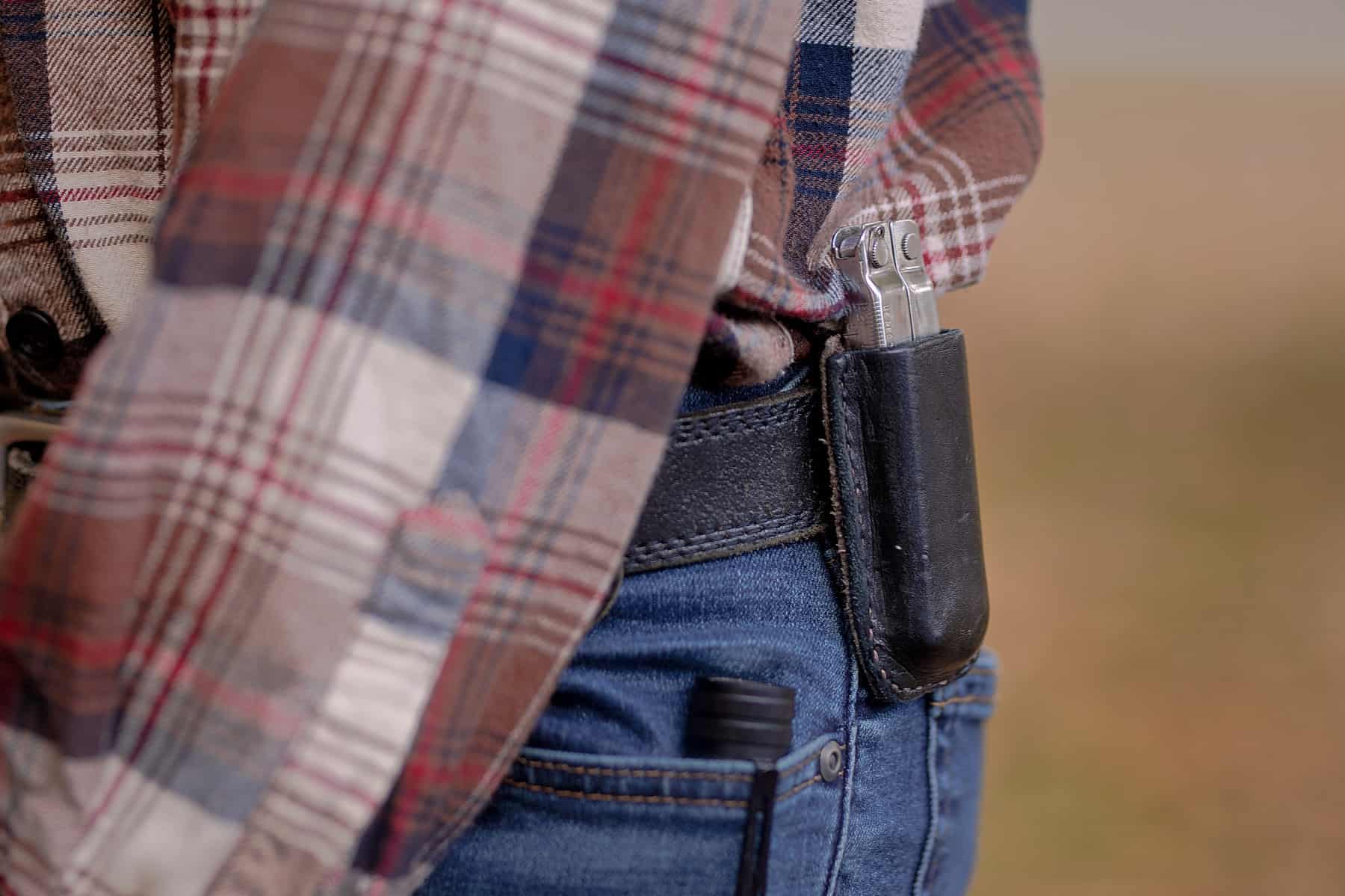
Leave a Reply